| THE ING NEWSLETTER | No. 5, October 2001 |
|
|
SCIENCE |
|
|
|
| Previous: | The SAURON Survey of Early-Type Galaxies in the Nearby Universe | Up: | Table of Contents | Next: | An International Review of ING |
Other available formats: PDF
The Central Kiloparsec of Starbursts and AGN: The La Palma Connection
Johan H. Knapen (ING & Univ. of Hertfordshire)
La Palma receives a steady stream of astronomical visitors throughout the year, most of whom come for short visits to observe using one of the telescopes on the island. In May 2001, however, over 100 astronomers flew in from around the globe for an astronomical research conference on the central kiloparsec of starbursts and AGN, organised by the Isaac Newton Group of Telescopes, and in fact the first major scientific conference organised wholly on La Palma.
The conference was held
from May 7 to 11, 2001, in Hotel Hacienda San Jorge in the small resort
town of Los Cancajos, located between Santa Cruz de La Palma and the airport.
The meeting was attended by 120 delegates from 15 countries, among whom
were many (about 50) from the USA, and several from as far away as Japan,
Australia, India, Brasil, and Chile. A number of people had to be disappointed
because the capacity of the hotel and conference room would not allow more
attendees. Only a minority of the participants had visited La Palma before,
and it is fair to say that all were impressed by the island, and by the
telescopes standing on its highest peak. The scientific programme was full
and included nine oral and two poster sessions. Long lunch breaks were
often used for further discussions or collaborative work. The social programme
included a lecture on the geography and biology of La Palma, a guided tour
of the telescopes at the Observatory followed by a typical Canarian meal
at a local restaurant, the conference dinner where an excellent meal was
ended with two Palmeran delicacies: Malvasia wine and puros (cigars),
and finally an excursion around the Southern part of the island.
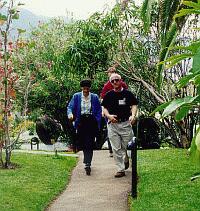 |
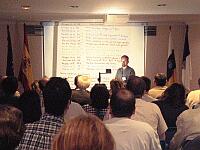 |
| Figure 1. Françoise Combes and Isaac Shlosman, two of the invited reviewers at the conference, walking on the grounds of the hotel Hacienda San Jorge. [ JPEG | TIFF ] | Figure 2. John Beckman giving his opening review talk on the first day of the conference. [ JPEG | TIFF ] |
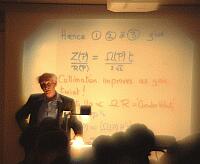 |
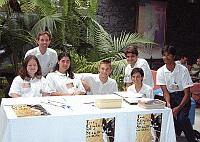 |
| Figure 3. Donald Lynden-Bell presenting his invited review on black holes and accretion jets. [ JPEG | TIFF ] | Figure 4. Part of the local organising committee. [ JPEG | TIFF ] |
The fact that many high-resolution studies of galaxies have been made using data obtained on La Palma makes the island a fitting "connection" to the field of study. In this field, recent advances in high-resolution observations, in theory and in modelling have focussed our attention on the central kiloparsec regions of nearby disk galaxies. These regions often show profound starburst and/or nonstellar (AGN) activity, accompanied by intricate gas and dust morphologies and kinematics. The origin and evolution of the phenomena occurring in these central regions, their possible causal interrelationships, links to the host galaxies, and the role the central regions play in galaxy evolution, form an intriguing subject which was the main topic of the conference.
The meeting brought together specialists in a relatively restricted area of astrophysics, which focussed the discussions and led to a very productive exchange of ideas. Some of the most important topics dealt with were, for instance, the detailed interconnection between an AGN and a starburst when both are present simultaneously in a galaxy, and detailed studies of the physics of star formation and of non-stellar activity, using tracers at wavelengths ranging from the X-ray to radio domains. The relations between the presence and properties of an AGN and/or a (circum)nuclear starburst on the one hand and the properties of its host galaxy on the other were explored at length, albeit without reaching clear conclusions. It does seem plausible that any such relation may be weakened by the AGN's destroying the evidence of its origin. For example, an AGN may destroy the bar which initially fuelled it. Also, both AGN and bars may work with specific "duty cycles", which can in principle imply that any non-active or non-barred galaxy as observed now, may have been active or barred some unspecified time in the past, or may become so sometime in the future. Significant collaborations between observers, theorists and modellers are needed to advance here.
Real progress is being made across the field though, thanks notably to a continuing stream of Hubble Space Telescope observations, to X-ray images obtained with new orbiting observatories, but also to imaging and spectroscopy from ground-based optical/near-infrared telescopes, such as ING's. In addition, numerical simulations of gas dynamics are progressing quickly, reaching higher resolutions and deepening our insight into a range of physical processes. For instance, a number of workers presented new results on nuclear spiral arms, which seem to occur rather frequently in the central regions of active and non-active galaxies, but which rather more infrequently take the shape of two-armed, "grand-design", spirals, such as those known well in disks of galaxies such as M51. Relationships between massive black holes, thought to be connected to AGN activity but also found frequently in non-active galaxies, and the bulges surrounding them received considerable attention. Other topics, not at first sight related directly to the main topic of the conference, took center stage at least at some point during the conference; these included attempts to quantify empirical relations between star formation and underlying gas density in disks, but also in the central kiloparsec regions.
It is appropriate to thank
the financial sponsors of the conference here. The Isaac Newton Group provided
cash and facilities before, during and after the conference, without which
we could not have organised it. The Excmo. Cabildo Insular de La Palma
(Island Government), and its Patronato de Turismo (Tourist Board) made
very generous contributions to the social programme, in particular a sumptuous
welcome reception, the beautiful conference dinner, and two excursions.
Our local organising committee, consisting of ING staff and students Daniel
Bramich, Begoña García Lorenzo, Joanna Holt, Javier Méndez,
Rachael Miles, Saskia Prins, Peter Sørensen, Aditya Tayal, and Almudena
Zurita, provided time, effort, and dedication to make all those seemingly
unimportant details fall into place, without which the conference could
never have become the success it was. We must also thank other staff who
helped out at various stages, for instance by locating missing registration
fee payments, by getting a linux PC talking to the outside world, or by
showing our distinguished visitors round the telescopes.
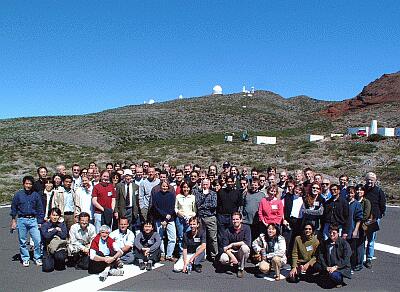 |
| Figure 5. Conference attendants at the Observatory. [ JPEG | TIFF ] |
The proceedings of the conference are now in press, and will be published later this year as a 750-page volume in the conference series of the Astronomical Society of the Pacific1. Although the proceedings necessarily focus on the status quo of research, as reported during the conference, the invited reviews and contributed papers set the stage for important breakthroughs in the field, which we anticipate both in the numerical aspects and due to new instrumental opportunities. The latter will allow observations with higher resolution, sensitivity, and area coverage, and at more wavelength bands, than ever before. With instruments like OASIS, ING can be expected to continue to play a vital role in this field.
Symbiotic Stars Probing Stellar Evolution
ING is organising a second astronomy research conference, on the topic of "Symbiotic Stars Probing Stellar Evolution", to be held in May 2002 in La Palma. Information on this conference can be found on ING's webpages: http://www.ing.iac.es/ conferences/symbiotics/
Email contact: Johan Knapen (knapen@ing.iac.es). More information: http://www.ing.iac.es/conferences/centralkpc/
1: The Central Kiloparsec of Starbursts and AGN: the La Palma Connection, eds. J. H. Knapen, J. E. Beckman, I. Shlosman and T. J. Mahoney, 2001, ASP conference series, vol. 249 (ASP: San Francisco), in press.
| Previous: | The SAURON Survey of Early-Type Galaxies in the Nearby Universe | Up: | Table of Contents | Next: | An International Review of ING |
| GENERAL | SCIENCE | TELESCOPES AND INSTRUMENTATION | OTHER NEWS FROM ING | TELESCOPE TIME |